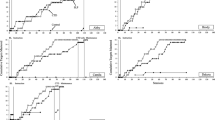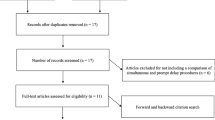Abstract
The effects of constant time delay, observational learning opportunities, and differential attentional cuing were examined during the small-group instruction of students in an integrated setting. Three students, one individual with moderate mental retardation and two individuals characterized as at-risk learners, participated in learning sight words through direct instruction and observational-learning conditions. A multiple probe design across three students was combined with a multitreatment design across treatment conditions to assess the impact of instructional variables. Reliability of scoring and procedural integrity were estimated and social validity of outcomes was considered. Findings support the salience of the constant time delay procedure in facilitating word acquisition in small, heterogeneous, and inclusive group learning arrangements. Further, a significant amount of learning through observation occurred for all students under both a general and specific attentional cue condition. A slight but discernible advantage of using the specific cuing strategy of transcribing target and nontarget words was realized.
Similar content being viewed by others
References
Bandura, A. (1968). Social learning theory of identification processes. In D. A. Glass (Eds.),Handbook of socialization theory and research. Chicago: Rand Mc Nally.
Bennett, D., Gast, D. L., Wolery, M., & Schuster, J. (1986). Time delay and system of least prompts: A comparison in teaching manual sign production.Education and Training of the Mentally Retarded, 21, 117–129.
Billingsley, F. F., & Romer, L. T. (1983). Response prompting and the transfer of stimulus control: Methods, research, and a conceptual framework.Journal of the Association for the Severely Handicapped, 8, 3–12.
Bimbrauer, J. S., Peterson, C. R., & Solnick, J. V. (1974). Design and interpretation of studies of single subjects.American Journal of Mental Deficiency, 79, 191–203.
Browder, D. M., Morris, W. W., & Snell, M. E. (1981). Using time delay to teach manual signs to a severely retarded student.Education and Training of the Mentally Retarded, 16, 252–258.
Browder, D. M., Schoen, S. F., & Lentz, F. E. (1987). Learning to learn through observation.Journal of Special Education, 20, 447–461.
Gast, D. L., Wolery, M., Morris, L., Doyle, P. M., & Meyer, S. (1990). Teaching sight word reading in a group instructional arrangement using constant time delay.Exceptionality, 1, 81–96.
Halle, J., Marshall, A., & Spradlin, J. (1979). Time delay: A technique to increase language use and facilitate generalization in retarded children.Journal of Applied Behavior Analysis, 12, 431–439.
Hartmann, D. P. (1977). Consideration in the choice of interobserver reliability estimates.Journal of Applied Behavior Analysis, 10, 103–116.
Horner, R. D., & Baer, D. M. (1978). Multiple-probe techniques: A variation on the multiple baseline.Journal of Applied Behavior Analysis, 11, 189–196.
Keel, M. C., & Gast, D. (1992). Small-group instruction for students with learning disabilities: Observational and incidental learning.Exceptional Children, 58, 357–368.
Kinney, P. G., Stevens, K. B., & Schuster, J. W. (1988). The effects of CAI and time delay: A systematic program for teaching spelling.Journal of Special Education Technology, 9, 61–72.
Koury, M., & Browder, D. M. (1986). The use of time delay to teach sight words by peer tutors classified as moderately mentally retarded.Education and Training of the Mentally Retarded, 21, 252–258.
Oliver, P. R. (1983). Effects of teaching different tasks in group versus individual training formats with severely handicapped individuals.Journal of the Association for the Severely Handicapped, 8, 79–91.
Schoen, S. F., Lentz, F. E., & Suppa, R. (1986). An examination of two prompt fading procedures and opportunities to observe in teaching handicapped preschoolers self-help skills.Journal of the Division for Early Childhood, 12, 349–358.
Schoen, S. F., & Sivil, E. O. (1989). A comparison of procedures in teaching self-help skills: Increasing assistance, time delay, and observational learning.Journal of Autism and Developmental Disorders, 19, 57–72.
Snell, M. E., & Gast, D. L. (1981). Applying time delay procedures to the instruction of the severely handicapped.Journal of the Association for the Severely Handicapped, 6, 3–14.
Tawney, J. W., & Gast, D. L. (1984).Single subject research in special education. Columbus, OH: Charles E. Merrill.
Touchette, P. E. (1971). Transfer of stimulus control: Measuring the moment of transfer.Journal of Experimental Analysis of Behavior, 15, 347–354.
Voeltz, L. M., & Evans, I. M. (1983). Education validity: Procedures to evaluate outcomes in programs for severely handicapped learners.Journal of the Association for the Severely Handicapped, 1, 3–13.
Wolery, M., Ault, M. J., Gast, D. L., Doyle, P. M., & Mills, B. M. (1990). Use of choral and individual spelling attentional responses in teaching sight word reading during small group instruction.Remedial and Special Education, 11, 47–58.
Wolery, M., Cybriwsky, C. A., Gast, D. L., & Boyle-Gast, K. (1991). Use of constant time delay and attentional responses with adolescents.Exceptional Children, 57, 462–474.
York, J., Vandercook, T., Mac Donald, C., Heise-Neff, C.,&, Caughie, E. (1992). Feedback about integrating middle-school students with severe disabilities in general education classes.Exceptional Children, 58, 244–258.
Author information
Authors and Affiliations
Additional information
Gratitude is extended to Gail Mc Gregor, Temple University, for her feedback on the initial draft of this paper.
Rights and permissions
About this article
Cite this article
Schoen, S.F., Ogden, S. Impact of time delay, observational learning, and attentional cuing upon word recognition during integrated small-group instruction. J Autism Dev Disord 25, 503–519 (1995). https://doi.org/10.1007/BF02178297
Issue Date:
DOI: https://doi.org/10.1007/BF02178297




